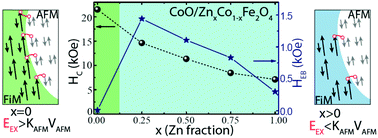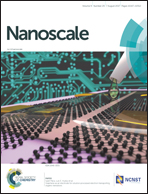Tuning the coercivity and exchange bias by controlling the interface coupling in bimagnetic core/shell nanoparticles†
Abstract
In order to explore an alternative strategy to design exchange-biased magnetic nanostructures, bimagnetic core/shell nanoparticles have been fabricated by a thermal decomposition method and systematically studied as a function of the interface exchange coupling. The nanoparticles are constituted by a ∼3 nm antiferromagnetic (AFM) CoO core encapsulated in a ∼4 nm-thick Co1−xZnxFe2O4 (x = 0–1) ferrimagnetic (FiM) shell. The system presents an enhancement of the coercivity (HC) as compared to its FiM single-phase counterpart and exchange bias fields (HEB). While HC decreases monotonically with the Zn concentration from ∼21.5 kOe for x = 0, to ∼7.1 kOe for x = 1, HEB exhibits a non-monotonous behavior being maximum, HEB ∼ 1.4 kOe, for intermediate concentrations. We found that the relationship between the AFM anisotropy energy and the exchange coupling energy can be tuned by replacing Co2+ with Zn2+ ions in the shell. As a consequence, the magnetization reversal mechanism of the system is changed from an AFM/FiM rigid-coupling regime to an exchange-biased regime, providing a new approach to tune the magnetic properties and to design novel hybrid nanostructures.



 Please wait while we load your content...
Please wait while we load your content...